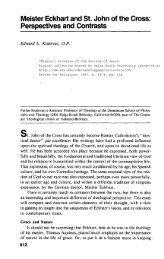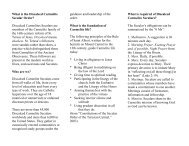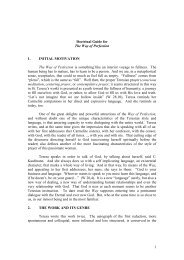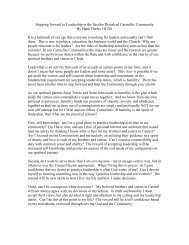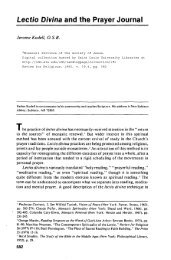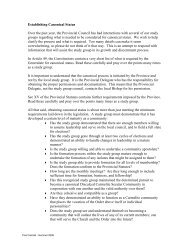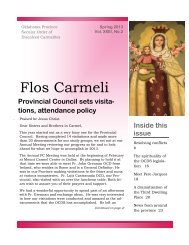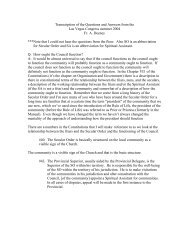OCDS Provincial Statutes for Central Province - Secular Carmelites ...
OCDS Provincial Statutes for Central Province - Secular Carmelites ...
OCDS Provincial Statutes for Central Province - Secular Carmelites ...
You also want an ePaper? Increase the reach of your titles
YUMPU automatically turns print PDFs into web optimized ePapers that Google loves.
<strong>OCDS</strong> <strong>Provincial</strong> <strong>Statutes</strong> <strong>for</strong> the Oklahoma <strong>Province</strong>PREFACEThe Constitutions of the <strong>Secular</strong> Order of Discalced <strong>Carmelites</strong> are the fundamental,general laws <strong>for</strong> its members. <strong>Provincial</strong> <strong>Statutes</strong> are to complete and adapt these generallaws where and as permitted in the Constitutions [Constitutions, Preface].The present statutes are the general law <strong>for</strong> Carmelite <strong>Secular</strong>s of the Oklahoma<strong>Province</strong>. They are also binding upon those Carmelite <strong>Secular</strong>s residing in the UnitedStates under the jurisdiction of the Cracow <strong>Province</strong> until such time as the Cracow<strong>Province</strong> assumes responsibility <strong>for</strong> the <strong>Secular</strong>s within their United States province.*All references to the <strong>Provincial</strong> Council are referring to the <strong>OCDS</strong> <strong>Provincial</strong> Counciland not the <strong>Provincial</strong> Council of the Friars.Section I : Formation1) There are three periods of Formation.a) A twelve month aspirancy [Art. 36a]b) Formation <strong>for</strong> First Promise, which lasts two years [Art. 36b]c) And Formation <strong>for</strong> Definitive Promise, which lasts three years [Art. 36d]2) The <strong>for</strong>mal aspirancy period mentioned in Article 36a shall be twelve months. 1 Theperiod of aspirancy <strong>for</strong>mally starts when the Local Council invites an individual tobegin the introductory study of the Carmelite <strong>Secular</strong> charism in preparation <strong>for</strong>acceptance into the community.3) When an aspirant is clothed in the large brown scapular, the more serious period of<strong>for</strong>mation mentioned in Article 36b begins.4) The candidate normally retains his or her baptismal name. A title of devotion may beadded to one’s baptismal name, if desired, when the candidate makes the FirstPromise.5) Either of the two periods of Formation after clothing may be extended if it isdetermined (normally by the Local Council) to be in the best interest of the candidate.a) The first period of Formation (be<strong>for</strong>e the First Promise) may be extended <strong>for</strong> onemore year.1 This period includes months when there is no community meeting due to Days of Recollection, retreat, etc.
) The second period of Formation (be<strong>for</strong>e the Definitive Promise) may be extendedup to one and a half more years.6) When the Spiritual Assistant is unable to preside, no special delegation is needed <strong>for</strong>the Local Council to ask another priest or deacon to clothe candidates and receivePromises and vows [Ritual 13, 31, 51, 67].Section II: IsolatesCommunity is an integral part of the Carmelite <strong>Secular</strong> vocation [cf. Art. 9d, 26, 36, 40].1) The <strong>Provincial</strong> Council shall assign isolates to a community. The President of thelocal community shall initiate contact with the isolate [Art. 56]. Ongoing contactmay be delegated by the President to one or more members of the community.2) There shall be monthly contact between the isolate and the community member. Thiscontact may be via phone, letter, or e-mail, or in person.3) In most cases, isolates in need of <strong>for</strong>mation will be assigned to a CanonicalCommunity, and the Director of Formation shall oversee initial <strong>for</strong>mation of isolates.Upon making the Definitive Promise, an isolate then may be transferred to a StudyGroup which may be geographically closer to the isolate.4) During initial <strong>for</strong>mation leading up to Definitive Promises, the isolate is required tomeet with the community at least once a year. All isolates are strongly encouraged tocontinue visits to the community at least once a year.Section III: Community Elections1) Community elections shall be held every three years in the spring prior to the<strong>Provincial</strong> elections of the Friars. The newly elected Local Council shall assume theirduties at the end of the meeting in which they are elected. To preserve freedom of thenewly elected Local Council, all other offices (Secretary, Treasurer, FormationDirector, etc.) shall be vacated at the end of the same meeting.2) Elections of the Community President and three Councilors shall be conducted inaccordance with recognized parliamentary procedures 2 with the following particularprovisions:a) A nominating committee of at least three professed members 3 may be appointedby the Local Council and the names of the committee members shall be2 e.g. Robert’s Rules of Order.3 Those who have made at least their First Promise.2
announced to the members at a meeting approximately one month in advance ofthe meeting when the election is to take place.b) The nominating committee shall select qualified nominees <strong>for</strong> each office whohave consented to serve if elected. For the office of President there should be twoor three nominees who have made their Definitive Promise [Art. 51]. For officeof the three Councilors there should be an adequate number of nominees. 4c) Only professed members may serve as members of the Local Council.d) In order that leadership qualities be developed in our communities, all councilmembers (President, councilors and Director of Formation) shall serve no morethan two consecutive terms. To be elected to a third consecutive term requires apostulation from the <strong>Provincial</strong> Council. 5e) The report of the nominating committee (list of nominees) shall be presented tothe members at the meeting at which the election shall take place. Nominees <strong>for</strong>President may also be nominated <strong>for</strong> the Councilor ballot if not elected asPresident.f) Only professed members are eligible to vote.g) Nominations may be made from the floor, and write-in votes shall be valid.h) Voting is to be by secret ballot. A quorum 6 of eligible voting members beingpresent, a majority 7 shall be required <strong>for</strong> election.i) Voting by letter or proxy shall be invalid.3) Election of the Presidenta) The Spiritual Assistant shall invoke the guidance of the Holy Spirit. In theabsence of the Assistant, this shall be the duty of the incumbent President.b) Election of the President shall be on a separate ballot from Councilors and shallprecede election of the Councilors.c) If a majority is not reached by any nominee on the first ballot, the names of thetwo nominees receiving the highest number of votes shall be placed on the second4Article 52 states that Councilors “generally are community members with Definitive Promise, [but] inparticular circumstances, members with First Promise can serve.”5 Postulation is a petition <strong>for</strong> exemption from the normal policy. When a candidate is not eligible to beelected to office, the candidate may be placed in that office by virtue of special permission of the properauthority. In this case that would be the <strong>Provincial</strong> Council.6 For the purposes of an election, a quorum is defined as the voting members present, provided notice ofthe election was given at the previous meeting.7 A number greater than half the legal votes cast.3
allot. If there is a tie on the second ballot, there shall be a third and final ballot.In the event of a tie on the third ballot, seniority of profession shall be thedetermining factor of the election. If there is a tie on the profession date, thenseniority by age shall determine the election.4) Election of the Local Councila) The outgoing President shall preside at the election and conduct it in accordancewith Sec. III.2 above.b) The three incumbent Councilors shall count and verify the votes, and theSecretary shall record them.c) The three Councilors shall be elected on a single ballot. Each voter shall enter onthe ballot their first, second, and third choice <strong>for</strong> Councilor. First choicecandidates shall receive three points in the tabulation of the ballots. Secondchoice two points, and third choice one point. 8 The candidates with the threehighest points shall be elected Councilors. The candidate with the fourth highestpoints shall be elected Councilor only if the Director of Formation is elected bythe Local Council from one of its newly elected members.d) In case of ties, the same rules outlined in Sec. III.3d above apply.5) The procedure <strong>for</strong> appointing the Secretary and Treasurer should be left to thediscretion of the newly elected Local Council. [cf. Arts. 54-55]Section IV: Remembrances of the Dead1) At the time of death of a community member:a) The President or a designated member of the community shall in<strong>for</strong>m themembers of the community of the member's death as soon as possible and providein<strong>for</strong>mation regarding the funeral.b) The President or a designated member shall contact the family of the deceased todetermine how the community may be of service and participate in the funeralservice. The desires of the family regarding funeral arrangements must always behonored.c) Those unable to attend the funeral shall participate in a Mass and receive HolyCommunion <strong>for</strong> the deceased, or remember the deceased in prayer, preferably the8 To eliminate confusion the nominating committee should prepare ballots in advance which look like this:First choice ____________________ [3 points]Second choice __________________[2 points]Third choice _____________________[1 point]4
Office <strong>for</strong> Dead.d) The community of the deceased shall prepare a short notice of death to send to the<strong>Central</strong> Office <strong>for</strong> publication in the <strong>Provincial</strong> newsletter.2) At the first meeting following news of the death of a member of the province(including friars and nuns), the community shall pray <strong>for</strong> the deceased member.3) Deceased members of the entire Order should be remembered in daily prayers,especially on the Feast of All Souls of the Carmelite Order.4) Members are to be encouraged to in<strong>for</strong>m their families regardinga) participation by their brothers and sisters in Carmel in the funeral servicesb) burial in their habit as a Carmelite <strong>Secular</strong>, namely the large brown scapularc) having the initials "<strong>OCDS</strong>" included on their headstone5) Each community shall maintain a necrology of the deceased members of thatcommunity.Section V: Vows1) Since the vows constitute a strictly personal and more complete offering of oneself,and there<strong>for</strong>e entail a greater moral responsibility [cf. RL, Art. 15], Carmelite<strong>Secular</strong>s desiring to take vows of obedience and chastity should go through a seriousdiscernment process. This discernment process should include discussions with theirpersonal spiritual director/confessor, if available, the Spiritual Assistant of the localcommunity, and the Local Council, and requires the permission of the <strong>Provincial</strong> orhis delegate [cf. Art. 40].2) Carmelite <strong>Secular</strong>s may be permitted to take vows of obedience and chastity nosooner than five years after making the Definitive Promise.3) A Carmelite <strong>Secular</strong> who has made vows and wishes to leave the order and/or bedispensed from those vows must request dispensation via the <strong>Provincial</strong> Delegate[CCL 1196].5
Section VI: Age RequirementsA candidate <strong>for</strong> admission to <strong>for</strong>mation in the <strong>Secular</strong> Order must be at leasteighteen years of age.Section VII: Community Size1) Communities are encouraged to limit their size in order to maintain a strong sense ofintimacy within the community. The more the members know one another and sharewith one another, the greater the opportunity to love one another.2) It is left to the discretion of each community as to the maximum number of membersit should have. As the size of the community approaches that number, discussionsshould start regarding the process of <strong>for</strong>ming a second community. Formation of thesecond community shall follow the same process as outlined in the statutes relating tothe establishment of a new community (Sec. XV).3) The Local Council of the community shall contact the <strong>Provincial</strong> Council advising itthat the community is approaching or has reached its maximum size and may need to<strong>for</strong>m a second community. The <strong>Provincial</strong> Council shall provide policy on the factorsto be taken into account when deciding how to split a community.Section VIII: Apostolate1) Apostolate is a duty and requirement of each baptized and confirmed person [AA 1.3;CCL 225.1]. Even the most interior soul must respond to the demands of charity insome <strong>for</strong>m or fashion, and thus all Carmelite <strong>Secular</strong>s are called to have an apostolate[Art. 27]. Through their apostolic endeavors, Carmelite <strong>Secular</strong>s demonstrate how itis possible to seek intimate union with God even in the midst of worldly duties andconcerns, in addition to responding to the Gospel's call to serve one another. In thisway, they share in the prophetic mission of Christ to which they are called in baptismand put into practice the prophetic dimension of the Carmelite charism.2) While priority is given to those places where the apostolic commitment is individual(the family, one's profession or work), each <strong>OCDS</strong> canonical community should havean apostolic commitment as well 9 . A report of the community's apostolic endeavorsshall be included as part of the triennial community report turned in prior to thePlenary Council [Sec. XIX.3].3) The Carmelite community apostolate is to share Carmelite spirituality.9 c.f. Fr. Camilo Macisse, 1986 letter to Spain National Congress6
4) In considering an apostolate, the community needs to be sensitive to the feelings,interests, abilities and talents, and physical and financial capabilities of the membersof the community working together as a whole.5) Formation in the apostolate shall be part of every <strong>for</strong>mation program so that eachCarmelite <strong>Secular</strong> may contribute to the community apostolate once they have beenprofessed.6) Since the local bishop is to foster various <strong>for</strong>ms of organized apostolate in his diocese[CCL 394], the community may need to consult with the local diocesan officerelative to the possible need <strong>for</strong> the Bishop's approval. The Spiritual Assistant or alocal pastor may be consulted first if there is any question about the need <strong>for</strong>approval.Section IX: External Signs of Membership1) The large ceremonial brown scapular shall be given as the habit of the <strong>Secular</strong> Orderat the time of admission to <strong>for</strong>mation.2) A smaller brown scapular or scapular medal is worn <strong>for</strong> everyday use.3) The ceremonial scapular may be worn at community meetings as well as atceremonial and/or liturgical events of the Carmelite Order. It may also be worn atevents at which the Carmelite Order wishes to be recognized (e.g. wakes and funeralsof our members). Any Local Councilor may determine which events fall into thislatter category.Section X: Marian Devotions1) Discalced Carmelite <strong>Secular</strong>s honor Mary daily. We recognize her as Mother, sisterand model pray-er, disciple and one in service to God and the Church [Arts. 4, 29, 30& 31]. Carmelite <strong>Secular</strong>s wear the brown scapular of Our Lady of Mount Carmel, orthe scapular medal, as our habit.2) Carmelite <strong>Secular</strong>s recognize and value the diversity of expressions of devotion toMary. Carmelite <strong>Secular</strong>s especially pay attention to the Christocentric aspect ofthose Marian devotions which should always lead us into even closer relationship toOur Lord. As guidelines <strong>for</strong> fostering proper Marian devotion, Carmelite <strong>Secular</strong>sshall look to the Church teachings on Mary found in Lumen Gentium, MariatusCultus, and Redemptoris Mater. 1010 see also: Rosarium Virginis Mariae, Directory on Popular Piety and the Liturgy.7
3) Carmelite <strong>Secular</strong>s are encouraged to remember the Marian character traditionallyattached to the months of May and October and shall be especially mindful of Mariandevotions during those months.Section XI: Feast Days and Fasting1) In addition to the days of fasting and of abstinence proper to the Church in the UnitedStates and in response to the encouragement of our bishops "to prepare <strong>for</strong> eachChurch festival by a day of particular self-denial, penitential prayer and fasting" [cf.National Conference of Catholic Bishops, Pastoral Statement, "Penitent-Discipline inthe United States", Washington, DC, 1966] and to our Carmelite traditions, ourmembers, unless excused by reason of illness, shall fast on the vigils of the followingfeast days:Our Blessed Lady of Mount Carmel [Jul 16]The Prophet Elijah [Jul 20]St Therese of the Child Jesus [Oct 1]Our Holy Mother, Teresa of Jesus [Oct 15]All Saints of the Order [Nov 14]Our Holy Father John of the Cross [Dec 14]Feast day of the patron of the local community2) For sufficient reason, the above fast days may be anticipated. Anticipation shouldnever involve fasting on Sundays and Holy Days [cf. CCL 1249-1253].3) It is recommended that each community consider the option of celebrating the feastby some <strong>for</strong>m of communal celebration or recreation (i.e., attending Mass together,meeting <strong>for</strong> a meal).Section XII: Transfers Within the <strong>Province</strong>1) When a member of the Oklahoma <strong>Province</strong> moves within the province and is nearanother community, that person shall contact that community and begin attending itsmeetings. After at least six meetings, the member may apply <strong>for</strong> official transfer tothe community. 112) A member who is transferring to a new community prior to Definitive Promise shallmeet with the Formation Director, who shall evaluate the <strong>for</strong>mation received to thatpoint. The Formation Director shall also contact the previous Formation Director toobtain further in<strong>for</strong>mation and details of the <strong>for</strong>mation received. The member shallcomplete <strong>for</strong>mation with the new community. This may mean some repetition ofmaterial covered in the previous community's program and/or guided study of11 Official transfer <strong>for</strong>ms may be obtained from the <strong>Central</strong> Office.8
material already covered by the new community in its program. After the transfercandidate is evaluated by the Formation Director, the final decision about <strong>for</strong>mationstatus and readiness is made by the Local Council of the new community.3) If <strong>for</strong> whatever reason the Local Council of the new community does not accept atransferring member, the member shall petition the <strong>Provincial</strong> Council <strong>for</strong> transfer toisolate status.4) Members who move within the province and are no longer near a community shallapply to the <strong>Provincial</strong> Council <strong>for</strong> transfer to isolate status [Sec. II].5) The member shall either transfer to a new community or seek isolate status no morethan a year after moving to a new location.Section XIII: Transfers Between <strong>Province</strong>s1) Carmelite <strong>Secular</strong>s fall under the juridical authority of the province in which theyreside. When someone from another province moves into the Oklahoma <strong>Province</strong>,the same transfer procedures as in Sec. XII shall apply.2) When a member of the Oklahoma <strong>Province</strong> moves into another province, thatmember shall contact the <strong>Provincial</strong> Office of the new province <strong>for</strong> in<strong>for</strong>mation andprocedures <strong>for</strong> transferring into that province. The transferring member can obtaincontact in<strong>for</strong>mation <strong>for</strong> the U.S. <strong>Province</strong>s from the <strong>Central</strong> Office of the Oklahoma<strong>Province</strong>.Section XIV: Transfers of TOCs to <strong>OCDS</strong>Third Order members of the Ancient Observance of Carmel (hereafter TOC) who desireto become Discalced Carmelite <strong>Secular</strong>s shall follow the same procedures as Sec. XIIIwith the following differences:1) Once the Formation Director has obtained in<strong>for</strong>mation from the <strong>for</strong>mer communityand met with the candidate, he/she shall consult the <strong>Provincial</strong> Council <strong>for</strong> guidanceon the level of <strong>for</strong>mation the candidate should enter. It is assumed that at least some<strong>for</strong>mation regarding the differences in charism shall be needed, and additional<strong>for</strong>mation in other areas may be required.2) Even if the candidate has been definitively promised in the TOC, a period of FirstPromise in <strong>Secular</strong> Carmel shall be observed be<strong>for</strong>e the candidate is admitted toDefinitive Promise. Permission of the <strong>Provincial</strong> Council may be obtained to shortenthe period in First Promise <strong>for</strong> the TOC being admitted to <strong>OCDS</strong>.9
3) A TOC who was in initial <strong>for</strong>mation prior to seeking this change may be admitted to<strong>OCDS</strong> <strong>for</strong>mation using the Rite <strong>for</strong> Admission to Formation. If the candidate hasalready been clothed in the brown scapular, then that part of the ritual should bepassed over. Admission to First Promise would be made using the Rite <strong>for</strong> Promisewithout change.Section XV: Canonical Establishment of a Community1) Individuals interested in the possibility of establishing an <strong>OCDS</strong> community may,with the consent of the <strong>Provincial</strong> Council and under its supervision, <strong>for</strong>m a groupfocused on what it means to be Carmelite <strong>Secular</strong> in terms of its personal andcommunal responsibilities. This shall be the first stage in the process of becoming anestablished <strong>OCDS</strong> community, during which there is a discernment regarding thedetermination, cohesiveness, and compatibility as a group to continue on togethertoward this goal. At this stage the group shall be known as a Group in Discernment.2) Once the <strong>Provincial</strong> Delegate appoints a Spiritual Assistant and Director ofFormation, this Group in Discernment assumes the status of a recognized StudyGroup, under the supervision of the <strong>Provincial</strong> Delegate and the <strong>Provincial</strong> Council.a) After the Study Group has existed <strong>for</strong> a period of time, it may petition the<strong>Provincial</strong> Council <strong>for</strong> election of a provisional Local Council. The length ofservice and size of this provisional council may vary depending on how long thegroup has been in existence and the approval of the <strong>Provincial</strong> Council.b) The Local Council of a Study Group is authorized only to admit candidates to<strong>for</strong>mation (i.e. to clothe them in the large scapular and process them through thetwo year initial <strong>for</strong>mation program). It then evaluates the candidate’s suitability tomake his/her first promise and submits that evaluation to the <strong>Provincial</strong> Council,which reserves the right to admit the person to the promises and vows.c) The <strong>Provincial</strong> Delegate reserves the right to appoint and replace all Councilors ofStudy Groups. The rest of Article 47 of the Constitutions applies equally tocanonical Communities and Study Groups alike.d) The <strong>Provincial</strong> Council shall designate a canonical community in the province toserve as a sister community to new Study Groups. The canonical communityshall act as a resource to the group. The canonical community may assist theGroup by inviting its members to join community retreats, offering presentationson specific topics, sharing <strong>for</strong>mation materials, etc. In some cases, the <strong>Provincial</strong>Delegate may assign a member of the canonical community to serve as Directorof Formation <strong>for</strong> the Study Group.10
Section XVI: Community Life“Concern <strong>for</strong> the needs and good of others in the community is a principle of our Rulethat guides our Carmelite life.” [Art. 6e] “A fundamental element of our vocation is toinfuse prayer and life with apostolic zeal in a climate of human and Christiancommunity.” [Art. 9d]1) The <strong>OCDS</strong> Community is a local manifestation of the Carmelite family.2) In order to foster a climate of human and Christian community [Art. 9d], the localcommunity shall meet at least once a month. These meetings shall provide <strong>for</strong> theongoing <strong>for</strong>mation of all members by a spiritual conference, <strong>for</strong> the group to transactbusiness of the order, to pray together, and to further fraternal charity [cf. RL 19].3) Where possible, communities are encouraged to share resources with other localcommunities, such as Days of Recollection, special programs, or celebrations relatedto the Carmelite charism.4) Communities are encouraged to have an annual retreat. This may also serve as anopportunity to foster relations between communities by gathering together <strong>for</strong> aregional retreat.5) Community life is central to the Carmelite charism. There<strong>for</strong>e, attendance atmeetings is expected. Attendance is so important that the Local Council shall make apolicy regarding attendance. Lack of regular attendance, <strong>for</strong> reasons other than age orinfirmity, may be cause <strong>for</strong> dismissal.6) The community shall take responsibility <strong>for</strong> keeping aged and infirm membersinvolved in communal life by maintaining regular contact.7) The Local Council may approve a one-year leave of absence <strong>for</strong> those in DefinitivePromise 12 <strong>for</strong> a serious reason. The leave of absence may be renewed by the LocalCouncil <strong>for</strong> up to two more years. Further extensions may be applied <strong>for</strong> through the<strong>Provincial</strong> Council.8) The Local Council is the immediate, competent authority of the local communitywithin the limits of the Constitutions of the <strong>Secular</strong> Order of Discalced <strong>Carmelites</strong>[Art. 47]. In exercising its responsibilities, the Local Council has the authority todevelop the appropriate methods and means necessary to facilitate the physical andspiritual growth and well-being of the community. It is charged with theresponsibility of seeing that the members are nurtured spiritually into anunderstanding of the Promise which makes them members of the Order according totheir state in life. Consequently, the Local Council should assess the communitysituation and determine what is needed to build and sustain a community and nurture12 Cf. Sec. I <strong>for</strong> leaves of those in <strong>for</strong>mation.11
its members. As needed, the Local Council shall appoint members to serve thecommunity in various responsibilities not already outlined in the Constitutions or<strong>Statutes</strong> [cf. Art. VII, 52-55], such as facilitators of <strong>for</strong>mation groups, infirmarian,newsletter editor, or retreat coordinator.9) A member may, <strong>for</strong> a sufficient reason, ask to leave the Order, in which case theLocal Council should consent and release the member from the Promise (dismissalfrom vows is governed by Sec. V.3 above). The Local Council should not dismissanyone without providing an explanation to that person, nor should any member leavethe Order without providing an explanation to the Local Council [cf. RL, Art. 16].Section XVII: Prayer LifeThe members of our province shall practice mental prayer <strong>for</strong> at least one halfhour each day in an atmosphere of interior silence and solitude. [cf. RL, Art. 4]Section XVIII: Finances1) The local community shall determine the amount of dues to be assessed eachmember. The amount shall be dependent on the size of the community and its fiscalresponsibilities and needs. A member's inability to pay dues, temporarily orindefinitely, is a matter to be handled by the Local Council with discretion andsensitivity. If necessary, more affluent members are encouraged to contribute more tomake up any loss of income. Members start paying dues once they have beenclothed. Aspirants are welcome to voluntarily pay dues prior to clothing. Dues maybe collected monthly, quarterly, or annually.2) Dues collected should include monies to be distributed to help the poor [Art.55].Communities may make additional contributions to other worthy causes.3) The <strong>Province</strong> shall collect annual dues to help cover expenses of the <strong>Central</strong> Office,<strong>Provincial</strong> Delegate, and <strong>Provincial</strong> Council. A portion of these dues shall also be<strong>for</strong>warded by the <strong>Central</strong> Office to the General Secretariat of the <strong>Secular</strong> DiscalcedCarmelite Order and to the Carmelite Institute to support their functioning. The<strong>Central</strong> Office will send out a notice of dues in January of each year. Dues should bepaid by March 31. The <strong>Central</strong> Office shall publish a provincial financial report inthe spring issue of the <strong>OCDS</strong> provincial newsletter.4) The Treasurer of each community shall submit a financial report to the <strong>Province</strong> (viathe <strong>Central</strong> Office) and the Local Council when provincial dues are submitted. Astandard report shall itemize the income and outflow of funds so that the <strong>Province</strong> andthe Local Council shall have an idea if the community is living in accord with thespirit of the Constitutions. The Treasurer shall also submit a financial report to theLocal Council in September [Art. 55].12
Section XIX: Plenary Council1) There shall be a Plenary Council held at each <strong>OCDS</strong> Congress of the Oklahoma<strong>Province</strong>. Each Community shall send two members (President and an electedrepresentative) to that council. Each Study Group shall have one representative.2) The Plenary Council shall serve as a consultative body to the <strong>Provincial</strong> Council and<strong>Provincial</strong> Delegate. The Plenary Council shall be a means to encourage relationshipand communication among the <strong>Provincial</strong> Council, the <strong>Provincial</strong> Delegate and theCommunities and Study Groups, as well as among the Communities and StudyGroups themselves. Representatives to the Plenary Council may bring importantissues of the <strong>Province</strong> to the attention of the provincial leaders at the time of thePlenary Council.3) Each Community and Study Group shall submit a written report prior to the PlenaryCouncil meeting. The <strong>Central</strong> Office shall provide the <strong>for</strong>mat of the report to eachCommunity and Study Group. The President of the <strong>Provincial</strong> Council shall give a"State of the <strong>Province</strong> Report" based on the triennial reports of the Communities andStudy Groups at the Plenary Council.Section XX: <strong>OCDS</strong> <strong>Provincial</strong> Council“Where there is an organized circumscription of the friars of the Order, the <strong>Secular</strong>Order is to <strong>for</strong>m a <strong>Provincial</strong> Council to assist one another better in <strong>for</strong>mation and theapostolate…” [Art. 57]1) The <strong>OCDS</strong> <strong>Provincial</strong> Council shall consist of five Definitively Promised members ofour province, with the right to vote on matters pertaining to our life. Each shall servea six-year term. The terms shall be staggered so that two or three members areelected every three years. Councilors may not serve two consecutive terms.2) Elections <strong>for</strong> <strong>Provincial</strong> Council positions shall be held every three years, after LocalCommunity elections. Canonical Communities may each nominate one candidate <strong>for</strong>the <strong>Provincial</strong> Council. The <strong>Central</strong> Office shall send nomination <strong>for</strong>ms to theCommunities.3) The <strong>Provincial</strong> Council and the <strong>Provincial</strong> Delegate shall choose a total of fivecandidates from these nominees <strong>for</strong> open <strong>Provincial</strong> Council positions and confirmtheir willingness to serve. Voting <strong>for</strong>ms will then be mailed to each CanonicalCommunity and Study Group. Canonical Communities will vote <strong>for</strong> two candidateswhile Study Groups will vote <strong>for</strong> one candidate. The voting <strong>for</strong>ms shall returned tothe <strong>Central</strong> Office by the deadline given. The voting <strong>for</strong>ms shall be signed by thePresident of the community or the Formation Director of Study Groups without a13
President. At least one other Council member (or Study Group member) shall signthe voting <strong>for</strong>m. Depending on the number of <strong>Provincial</strong> Councilors being elected,the 2 or 3 receiving the highest number of votes will be elected to office. The<strong>Provincial</strong> Delegate will contact the nominees to in<strong>for</strong>m them of the results of theelection. Results of the <strong>Provincial</strong> Council election will be announced in the nextprovincial newsletter.4) The <strong>Provincial</strong> Council has the authority to replace, <strong>for</strong> a serious reason, a member ofthe <strong>Provincial</strong> Council itself [cf. Art. 47d].5) The <strong>Provincial</strong> Council shall elect a president every three years after new membersare elected.6) The President shall coordinate the work of the <strong>Provincial</strong> Council and preside at itsmeetings. The President shall also preside at meetings of the Plenary Council.7) Members of the <strong>Provincial</strong> Council shall make visitations. A Councilor, whilemaking visitation, comes as a representative of the <strong>Provincial</strong> with the rights andprivileges of that office. The visitator respects the autonomy of the Local Council’sauthority. 138) The <strong>Provincial</strong> Council shall appoint representatives to the National Council. ThePresident of the <strong>Provincial</strong> Council shall always serve as one of the National Councilrepresentatives.9) The <strong>Provincial</strong> Council shall appoint a liaison to the Spanish-speaking members ofour province. If this liaison needs to be selected from outside the <strong>Provincial</strong> Councilitself, the liaison shall be allowed to participate in all deliberations of the council.10) The <strong>Provincial</strong> Council may also appoint a secretary who is not a Councilor.11) The <strong>Provincial</strong>, the <strong>Provincial</strong> Delegate, and Local Councils may call upon the<strong>Provincial</strong> Council <strong>for</strong> assistance in resolving any difficulties that might arise withinthe province in relation to our <strong>Secular</strong> members.12) The <strong>Provincial</strong> Council shall assist the <strong>Provincial</strong> Delegate in guiding the <strong>for</strong>mationof a community from its inception through its discernment period, Study Groupstatus, and eventual request <strong>for</strong> canonical recognition. It shall also assist the<strong>Provincial</strong> Delegate in determining when a canonical community is no longer able tofunction and needs to have its status reduced.13) The <strong>Provincial</strong> Council may be contacted through the <strong>Central</strong> Office. 1413 The Councilor assists the local community without intervening in its government [Art. 57].14 The address of <strong>Provincial</strong> Secretary found in a current Flos Carmeli newsletter.14
14) The <strong>Provincial</strong> Council shall meet in person 15 once a year and more often ifnecessary.15) A representative of the <strong>Provincial</strong> Council shall attend meetings of the order asstipulated in Article 38 of the <strong>OCDS</strong> Constitutions.Section XXI: Formation GuidelinesThe <strong>Secular</strong> Order of Discalced <strong>Carmelites</strong> welcomes those of the faithful who, byspecial vocation, undertake to live in the world an evangelical life of fraternalcommunion (community) imbued with the spirit of contemplative prayer in imitation ofthe Virgin Mary (prayer), and animated with apostolic zeal (apostolate) according to theexample and teaching of Carmelite saints (study). (c.f. RL, Preface)1) Each stage of <strong>for</strong>mation includes goals in the areas ofa. Prayerb. Communityc. Apostolated. Studye. the Promise (<strong>for</strong> the stages leading to First and Definitive Profession)2) The goals outlined are considered the minimum requirements <strong>for</strong> each stage of<strong>for</strong>mation and shall be used as part of the discernment process at the end of each<strong>for</strong>mation period.3) These guidelines include a list of primary sources to be used during each <strong>for</strong>mationperiod. 16 While the primary sources provide an expectation of what should be readduring each <strong>for</strong>mation period, adjustments to meet the needs and abilities ofindividual persons are allowed. Formation Directors may supplement these sourceswith secondary materials. All secondary materials should be evaluated in light oftheir agreement with the Constitutions and current understanding of the Carmelite<strong>Secular</strong> vocation.4) From the period of initial <strong>for</strong>mation onwards, it should be emphasized that <strong>for</strong>mationis an ongoing, lifetime process in the life of the Carmelite <strong>Secular</strong> and an ongoingcommunal and individual responsibility (Art.33-35). The Local Council shall makeprovision <strong>for</strong> an ongoing <strong>for</strong>mation program <strong>for</strong> members who are DefinitivelyProfessed. On-going <strong>for</strong>mation shall continue the growth of the individual Carmelite<strong>Secular</strong> in the areas of prayer, community, apostolate, study, and living the Promise.It shall include the study of the texts of the <strong>Carmelites</strong> saints (Art. 34-35), documents15 Ordinary business of the council is handled through electronic postings.16 Should any of the required books go out of print, the <strong>Provincial</strong> Council will recommend a substitute. The<strong>Provincial</strong> Council may update articles (designated with * ) every 5 years to keep <strong>for</strong>mation materialscurrent. Updates will be distributed to all Local Councils at that time.15
of the Church and of the Order (Art. 33, 35-36), occasional review of the <strong>OCDS</strong>legislative texts, and other materials that support the Carmelite <strong>Secular</strong> vocation (Art35-36) as determined by the Local Council.16
5) Goals during Aspirancy (one year) shall bea. Prayeri. Learn to pray Morning and Evening Prayer of the Liturgy of the Hoursii. Begin to work at least 15 minutes of mental prayer into daily scheduleiii. Attend daily Mass as far as possibleiv. Learn to examine conscience (the examen)v. Understand the teachings of the Church and the Discalced CarmeliteOrder regarding the ScapularPrimary Sources:General Instruction on the Liturgy of the HoursLectio Divina by Fr. Sam Anthony MorelloCatechesis and Ritual <strong>for</strong> the Scapular of Our Lady of Mt Carmelb. Communityi. Attend Meetingsii. Be compatible with the other membersiii. Understand the communal dimension of the call 17Primary Sources:*The New <strong>OCDS</strong> Legislation and the Vocation to Carmel by Fr.Aloysius Deeneyc. Apostolatei. Become aware of the mission of the laity in the Churchii. Understand the compatibility of duties of state of life with Carmeliteway of lifeiii. Develop a basic understanding of the <strong>OCDS</strong> vocation and our call toholinessPrimary Sources:Constitutions of the <strong>Secular</strong> Order of Discalced <strong>Carmelites</strong><strong>OCDS</strong> <strong>Provincial</strong> <strong>Statutes</strong> <strong>for</strong> the Oklahoma <strong>Province</strong>Cathechism of the Catholic Church - # 738-780Lumen Gentium - Chapter 517 An understanding of the ecclesial nature and the communal dimension of the call to the <strong>Secular</strong> Order: anunderstanding that the calling has both an interior and exterior voice. An understanding of the difference between the<strong>Secular</strong> Order and other church organizations/groups. It requires the invitation of the community through its council.(Art. 26, 38)17
d. Studyi. Receive an introduction to the history of the Discalced CarmeliteOrder and its saintsii. Receive an introduction to the Discalced Carmelite charismiii. Receive an introduction to the <strong>OCDS</strong> legislationPrimary Sources:Rule of St AlbertConstitutions of the <strong>Secular</strong> Order of Discalced <strong>Carmelites</strong><strong>OCDS</strong> <strong>Provincial</strong> <strong>Statutes</strong> <strong>for</strong> the Oklahoma <strong>Province</strong><strong>OCDS</strong> Ritual*Profile of an <strong>OCDS</strong> by Fr. Aloysius DeeneyCarmelite Spirituality in the Teresian Carmel by Paul Marie of theCross*A Touch of <strong>OCDS</strong> History by Elizabeth M. Korves6) Goals during the <strong>for</strong>mation period leading to First Promise (two years) shall bea. Prayeri. Learn how to be a cantor <strong>for</strong> Morning and Evening Prayerii. Understand the basic stages of prayeriii. Practice daily mental prayer <strong>for</strong> at least a half houriv. Express authentic devotion to MaryPrimary Sources:Cathechism of the Catholic Church - Part 4: PrayerThe Way of Perfection by St. Teresa of AvilaLumen Gentium - Chapter 8b. Communityi. Take an active role in community by participating in discussions andcommunity activitiesii. Show growth in communal virtues of humility, charity and detachmentiii. Demonstrate ability to work with othersPrimary Sources:The Way of Perfection by St. Teresa of AvilaCommunity and Growth by Jean Vanier, Chapters 1, 318
c. Apostolatei. Develop an awareness of the mission of Carmel within the Churchii. Develop an awareness of the apostolate of the laityiii. Support Carmelite religious with prayerPrimary Sources:Constitutions of the <strong>Secular</strong> Order of Discalced <strong>Carmelites</strong><strong>OCDS</strong> <strong>Provincial</strong> <strong>Statutes</strong> <strong>for</strong> the Oklahoma <strong>Province</strong>Lumen Gentium - Chapter 4Apostolicam Actuositatemd. Studyi. Receive an introduction to the texts of Carmelite saintsii. Learn the history of Carmel from 13 th Century to the 16 th CenturyRe<strong>for</strong>mPrimary Sources:Story of a Soul by St Therese of LiseauxWay of Perfection by St Teresa of AvilaContemporary Challenge of St John of the Cross: His Life and HisTeachings by Leonard Doohan*Historical Notes on the Carmelite Order by Gabriel Barry - Chapters2, 3, 9, 10e. Promisei. Make an in-depth Study of the Constitutions and <strong>Statutes</strong>ii. Understand the evangelical counselsiii. Understand the beatitudesiv. Understand how <strong>OCDS</strong> fit into the larger OrderPrimary Sources:Constitutions of the <strong>Secular</strong> Order of Discalced <strong>Carmelites</strong><strong>OCDS</strong> <strong>Provincial</strong> <strong>Statutes</strong> <strong>for</strong> the Oklahoma <strong>Province</strong><strong>OCDS</strong> Ritualbook on beatitudes to be chosen at the Formation Director's discretion*Chastity: This Only One Kind of Love by Gerald Al<strong>for</strong>d*Promise to be Poor by Gerald Al<strong>for</strong>d*Existential Obedience by Gerald Al<strong>for</strong>d19
7) Goals during the <strong>for</strong>mation period leading to the Definitive Promise (three years)shall bea. Prayeri. Learn how to lead Morning and Evening Prayerii. Demonstrate a perseverance in mental prayeriii. Demonstrate a perseverance in exameniv. Adopt Mary as model of contemplative prayerPrimary Sources:Interior Castle by St. Teresa of AvilaThe Spiritual Canticle by St. John of the CrossThe Ascent of Mt. Carmel by St. John of the CrossRedemptoris Materb. Communityi. Assume a communal sense of responsibility (i.e. willing to assume anoffice of service within the community)ii. Demonstrate a willingness to submit to the communal goodiii. Cultivate fraternal relations with other members of the OrderPrimary Sources:Community and Growth by Jean Vanier, Chapters 4, 6, 7c. Apostolatei. Demonstrate a commitment to the call of loveii. Begin to assist in the community apostolatePrimary Sources:Lumen GentiumGaudium et SpesChristifideles Laicid. Studyi. Continue the study of the texts of Carmelite saintsii. Learn the history of Carmel from the Re<strong>for</strong>m to PresentPrimary Sources:Journey to Carith: Sources and Stories of the Discalced <strong>Carmelites</strong> byPeter Thomas Rohrbachsee also listing under Prayer <strong>for</strong> this period of <strong>for</strong>mation20
e. Promisei. Continue an in-depth Study of the Constitutions and <strong>Statutes</strong>ii. Develop a deeper understanding of the evangelical counselsiii. Develop a deeper understanding of the beatitudesiv. Develop a deeper understanding of how <strong>OCDS</strong> fit into the larger Orderv. Understand the seriousness of the life-long commitmentPrimary Sources:Constitutions of the <strong>Secular</strong> Order of Discalced <strong>Carmelites</strong><strong>OCDS</strong> <strong>Provincial</strong> <strong>Statutes</strong> <strong>for</strong> the Oklahoma <strong>Province</strong><strong>OCDS</strong> Ritualbook on beatitudes to be chosen at the Formation Director's discretion*Beatitudes by Fr. Aloysius DeeneyBibliographic In<strong>for</strong>mation:Apostolicam Actuositatem, Vatican II, Pauline Books and Media, also available as part ofthe Documents of Vatican II from various publishers and available online.Ascent of Mt Carmel, St John of the Cross, Collected Works, ICS Publications,Washington DC.Beatitudes, Fr. Aloysius Deeney, available online and from <strong>Central</strong> Office.Carmelite Spirituality in the Teresian Carmel, by Fr. Paul Marie of the Cross, ICSPublications, Washington DC.Catechism of the Catholic Church, multiple publishers and also available online.Catechesis and Ritual <strong>for</strong> the Scapular of Our Lady of Mt Carmel, ICS Publications,Washington DC.Chastity: This Only One Kind of Love, Gerald Al<strong>for</strong>d, available online and from <strong>Central</strong>Office.Christifideles Laici, Pauline Books and Media and available online.Community and Growth, Jean Vanier, Paulist Press, Mahwah, NJ, 1989.Constitutions of the <strong>Secular</strong> Order of Discalced <strong>Carmelites</strong>, available online and inlegislation book available through the <strong>Central</strong> Office.21
Contemporary Challenge of St John of the Cross: His Life and His Teachings, LeonardDoohan, ICS Publications, Washington DC.Existential Obedience, Gerald Al<strong>for</strong>d, available online and from <strong>Central</strong> Office.Gaudium et Spes, Vatican II, Pauline Books and Media, also available as part of theDocuments of Vatican II from various publishers and available online.General Instruction on the Liturgy of the Hours, Congregation <strong>for</strong> Divine Worship, 1971.Printed in full in the 4 volume Liturgy of the Hours. Text also available online.Historical Notes on the Carmelite Order, Gabriel Barry, available online and from<strong>Central</strong> Office.Interior Castle, St Teresa of Avila, Collected Works, Vol. 2, ICS Publications,Washington DC.Journey to Carith: Sources and Stories of the Discalced <strong>Carmelites</strong>, Ptere ThomasRohrbach, ICS Publications, Washington DC.Lectio Divina, Fr. Sam Anthony Morello, ICS Publications, Washington DC.Lumen Gentium, Vatican II, Pauline Books and Media, also available as part of theDocuments of Vatican II from various publishers and available online.New <strong>OCDS</strong> Legislation and the Vocation to Carmel, Fr. Aloysius Deeney, availableonline and from <strong>Central</strong> OfficeProfile of an <strong>OCDS</strong>, Fr Aloysius Deeney, available online and from <strong>Central</strong> Office.Promise to be Poor, Gerald Al<strong>for</strong>d, available online and from <strong>Central</strong> Office.<strong>OCDS</strong> <strong>Provincial</strong> <strong>Statutes</strong> <strong>for</strong> the Oklahoma <strong>Province</strong>, available online and in legislationbook available through the <strong>Central</strong> Office.Redemptoris Mater, Pope John Paul II, Hunter Publishing, 1987 and online.Ritual of the <strong>Secular</strong> Order of Discalced <strong>Carmelites</strong>, available online and in legislationbook available through the <strong>Central</strong> Office.Rule of St Albert, available online and in legislation book available through the <strong>Central</strong>Office.Spiritual Canticle, St John of the Cross, Collected Works, ICS Publications, WashingtonDC.22
Story of a Soul, St Therese of Liseaux, ICS Publications, Washington DC.Touch of <strong>OCDS</strong> History, Elizabeth M Korves <strong>OCDS</strong>, available online and from <strong>Central</strong>Office.Way of Perfection, St Teresa of Avila, Collected Works, Vol. 2, ICS Publications,Washington DC.Abbreviations:AA = Apostolicam ActuositatemArt. = <strong>OCDS</strong> ConstitutionsCCL = Code of Canon LawRitual = Ritual of the <strong>Secular</strong> Order of Discalced <strong>Carmelites</strong>RL = 1979 <strong>OCDS</strong> Rule of LifeRule = Rule of St AlbertSec. = <strong>OCDS</strong> <strong>Provincial</strong> <strong>Statutes</strong> <strong>for</strong> the Oklahoma <strong>Province</strong>Roman ProtocolThe above text was approved by the Discalced Carmelite General Council convened inRome in its 61st session on 21 st of December 2004, Protocol number 272/2004 DF.23



